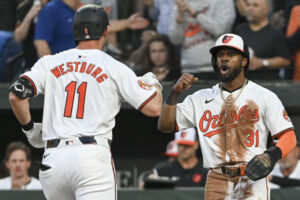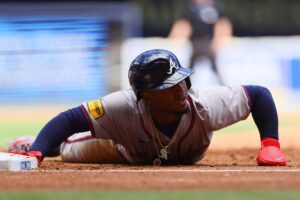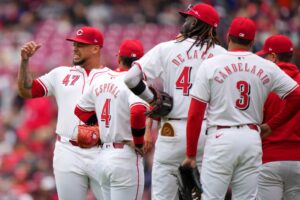The MLB Draft is scheduled to take place on June 10th, with the first round taking place at 7 p.m. ET. The second and final day of the draft will take place on June 11th starting at 5 p.m. ET. As a result, an MLB mock draft will give insight on who each team may take.
The 2020 draft has major strengths and weaknesses. The draft is very deep in college pitchers. There could be five to six pitchers in the first ten picks, and much more in the latter half of the round, in the “tier two” pitchers. A weakness of this draft is the shortstops. There will most likely only be two to three shortstops in the first round, and the first one taken could be in the latter half of the first round.
Here is the 2020 Last Word on Baseball MLB mock draft.
-
Detroit Tigers: Spencer Torkelson, 1B, Arizona State
A first baseman hasn’t been drafted number one overall since Adrian Gonzalez in the 2000 MLB draft. Spencer Torkelson has a chance to change that with an offensive skill set that is drawing comparisons to Mark Teixeira. Despite the shortened 2020 season, Torkelson continued to put up ridiculous numbers with a .598 OBP and six home runs in just 17 games.
2. Baltimore Orioles: Austin Martin, 3B/OF, Vanderbilt
If Torkelson goes number one, the Orioles will get a great “consolation” prize in Austin Martin. From a pure hitting perspective, Martin may be the best in the draft class and has developed power over his last two seasons in college. In addition to a plus hit tool, Martin offers great defensive versatility and above-average speed.
3. Miami Marlins: Asa Lacy, LHP, Texas A&M
With the third pick, the Marlins have a chance to draft an ace in Asa Lacy. Lacy possesses a legitimate four-pitch mix, with a mid 90s fastball and two plus offspeed pitches. With 46 strikeouts in just 24 innings in 2020, the Marlins can have a pair of elite pitching prospects with Sixto Sanchez and Asa Lacy.
4. Kansas City Royals: Emerson Hancock, RHP, Georgia
Emerson Hancock was in conversations for the number one overall pick coming into the Spring. He had four solid, but unspectacular starts in the abbreviated 2020 season, causing a slight drop in his stock. Nonetheless, Hancock has the potential to be an ace with an upper 90s fastball, and a plus slider, with a solid curveball.
5. Toronto Blue Jays: Max Meyer, RHP, Minnesota
Despite standing at just six feet, Max Meyer has a chance to fly up the minor league system, and potentially pitch in the 2020 season in a relief role. He attacks the strike zone with a mid 90s fastball, and has a plus slider along with it. After a group of young position players for the Blue Jays, they can build upon a solid pitching pipeline that already has top 10 prospect Nick Pearson.
6. Seattle Mariners: Nick Gonzales, 2B, New Mexico State
Seven of the last eight Mariners’ first-round picks have been college players. Nick Gonzales is one of the best hitters in the draft after batting .399 in his three years at New Mexico State, and a .747 slugging percentage. Defensively, there is room for improvement, but Gonzales showed growth in the 2019 season. With his plus hitting ability, he should be a staple at the top of the lineup for years to come.
7. Pittsburgh Pirates: Zac Veen, OF, Spruce Creek High School (Florida)
Zac Veen is thought by many to be the best high school player in the draft. He has an excellent swing, and has a chance to grow into his 6’4 frame to become a premier power bat in the major leagues. As an athlete, Veen is above-average with leaves the possibility of him remaining in center field at the next level. After trading Austin Meadows, the Pirates lack a stud outfield prospect, and Veen could fill that need in a big way.
8. San Diego Padres: Heston Kjerstad, OF, Arkansas
If there is a player with power similar to Spencer Torkelson, it is Heston Kjerstad from Arkansas. Kjerstad had 37 home runs in college and has a powerful swing from the left-hand side of the plate. Alongside his plus power, Kjerstad has a strong arm from the outfield, which make up for his lack of athleticism. This pick by the Padres could draw comparisons to the Hunter Renfroe pick in 2013.
9. Colorado Rockies: Reid Detmers, LHP, Louisville
The Rockies have taken college pitchers two out of the last three drafts, and could continue that theme in this year’s draft. Reid Detmers has a low 90s fastball, but makes up for that with the best curveball in the draft. He also has a plus change-up which gives him three solid pitches for the next level. The upside may not be as high as other pitchers in the draft, but Detmers is a safe pick who could be a number two starter.
10. Los Angeles Angels: Garrett Crochet, LHP, Tennessee
The Angels could go a much safer route with their need for pitching, but Garrett Crochet offers upside that rivals top-five talent. He has an upper 90s fastball, and an above-average slider which should play at the next level. Despite his electric stuff, Crochet offers major risk as he battled shoulder issues as well as struggling with command for parts of his college career.
11. Chicago White Sox: Jared Kelley, RHP, Refugio High School (Texas)
Jared Kelley provides elite upside as he had 331 strikeouts in just 139 innings in high school. Kelly has an easy and fluid upper 90s fastball, and a solid changeup to go along with it. For Kelley to be a starter at the next level, his slider must improve, which did show signs of growth throughout high school.
12. Cincinnati Reds: Patrick Bailey, C, NC State
After Tucker Barnhart has struggled over the past few years, the Reds need catcher depth in their farm system. Patrick Bailey is the best catching prospect in the draft this season. He is a solid defender behind the plate, and has shown power at NC State with a .302 career batting average.
13. San Francisco Giants: Nick Bitsko, RHP, Central Bucks East High School (Pennsylvania)
Nick Bitsko is another pitcher in this draft who has tremendous upside. He already has a solid three-pitch mix, with an upper 90s fastball. Bitsko has a plus curveball and a developing changeup alongside his big fastball. At 17 years of age, Bitsko provides a jolt to a Giants farm system that is deprived of top-tier pitching prospects.
14. Texas Rangers: Ed Howard, SS, Mount Caramel High School (Illinois)
In a weak draft for shortstops, Ed Howard is the consensus number one prospect in the draft. Howard possesses great bat speed, while showing great athleticism in the field. Being 18 years-old, Howard should fill into his frame and add more power to his game. With Elvis Andrus at 31 years-old, the Rangers could draft a high-schooler with solid upside to be his successor.
15. Philadelphia Phillies: Garrett Mitchell, OF, UCLA
Garrett Mitchell has an opportunity to be an everyday centerfielder for years to come in the MLB with his plus speed, defense, and hitting ability. He has a good line-drive swing, that could translate to more power at the next level. However, Mitchell has huge question marks medically as he has Type 1 diabetes, which could be a major red flag for teams.
16. Chicago Cubs: Robert Hassell, OF, Independence High School (Tennessee)
Robert Hassell is a two-way player that projects as a much better hitter at the next level. He has good athleticism in the outfield, and has a smooth swing that can add power at the next level. On the mound, Hassell as a 90 mph fastball, with a solid slider to go along with it. The Cubs could go for a college bat at this spot, but Hassell provides great upside in the latter half of the first round.
17. Boston Red Sox: Mick Abel, RHP, Jesuit High School (Oregon)
According to Jim Callis of MLB.com, the Red Sox are looking for upside in this year’s MLB draft. Abel already has a mid 90s fastball, and two developing offspeed pitches in his slider and changeup. Standing a 6’6, Mick Abel could grow into his frame and add two or three miles to his fastball to give him an elite fastball. The Red Sox could continue rebuilding their farm system by adding Abel, who would most likely become the number one pitcher in their system.
18. Arizona Diamondbacks: Cade Cavalli, RHP, Oklahoma
This is the area of the draft where the tier two college pitchers could start to get picked. The Diamondbacks could go outfielder here, but Cade Cavalli gives them pitching depth in a farm system with limited upside for starting pitching. Cavalli has a big fastball that is mid to upper 90s, and a strong power curve alongside it. There are injury and command question marks, but Cavalli has as much upside as any of these tier two pitchers.
19. New York Mets: Austin Hendrick, OF, West Allegheny High School (Pennsylvania)
Austin Hendrick seems like the prototypical corner outfielder in 2020. He has an uppercut swing which gives him the potential for 35+ home runs, but makes him susceptible to strikeouts. That could be a risk that the Mets would be willing to take in a farm system that could use a power outfielder. Another path the Mets could go is college pitcher, and take Cole Wilcox from Georgia.
20. Milwaukee Brewers: Cole Wilcox, RHP, Georgia
Another college pitcher is off the board with Cole Wilcox from Georgia. Being just 20-years old, Wilcox is less polished than his college counterparts, but provides more upside with a mid to upper 90s fastball, and two power offspeed pitches that have shown flashes of excellence. In 2019, Wilcox struggled with command with 38 walks in just 59.2 innings. However, in four starts in 2020, Wilcox struck out 32 batters in just 23 innings while walking just two. Wilcox has the potential to be a number two or three starter if he can become more consistent with his offspeed pitches and increase fastball command.
21. St. Louis Cardinals: Carmen Mlodzinski, RHP, South Carolina
Carmen Mlodzinski could fill a huge need for the Cardinals as he could be a fast riser in the farm system. After struggling his first two seasons, Mlodzinski blew up in the Cape Cod League, and was in talks to be a top ten pick before his junior season was cut short. Mlodzinski has a solid mid 90s sinker, and a hard cutter to go along with it. Projecting as a groundball pitcher with the potential to rack up strikeouts, Mlodzinski could help the Cardinals at the major league level sooner rather than later.
22. Washington Nationals: JT Ginn, RHP, Mississippi State
If there was a perfect match in the draft, it would probably be JT Ginn and the Nationals. Ginn was a projected top ten pick in the draft until he underwent Tommy John Surgery in March. Ginn’s fastball sits 94-96 with good movement, and a lethal slider that plays great contrast to his slider. Another plus trait for Ginn is his command. In his freshman season, Ginn had 105 strikeouts with just 19 walks. The Nationals have experience with taking players with risks such as Erick Fedde and Lucas Giolito.
23. Cleveland Indians: Tyler Soderstrom, C, Turlock High School (California)
Tyler Soderstrom is an intriguing prospect for many teams, who could go much earlier in the draft. On the hitting side, Soderstrom has tools to be an above-average hitter with solid power at the next level. He also possesses great athleticism, and this translates to plus speed on the basepaths. Soderstrom has tools to become a catcher as he transitions to professional ball, but must improve to be an average catcher defensively. Even if catcher does not work out, Soderstrom has athleticism to move into the field.
24. Tampa Bay Rays: Pete Crow-Armstrong, OF, Harvard-Westlake High School (California)
The Rays have not been afraid to take prep bats, and Pete Crow-Armstrong has as much upside as any high school player in this draft. Coming into 2019, Crow-Armstrong had aspirations to be a top-five pick, but fell after a bit of a disappointing season. He has elite defensive and athletic tools, and a solid hit tool. The primary question for Crow-Armstrong is whether his power will emerge, and if his bat can come close to his glove. The Rays could have a steal if Crow-Armstrong plays up to his potential.
25. Atlanta Braves: Tanner Burns, RHP, Auburn
The Braves could go for a college infielder here, but Tanner Burns should be a safe pick who could be a solid starter, or at very least, an above-average bullpen arm. Burns has a 94-97 mile per hour fastball that has late movement and a low 80s slider as his primary putout pitch. As a third pitch, he is developing a changeup that has shown flashes, but is not a consistent pitch. Burns also has durability issues as he stands in at just six feet.
26. Oakland Athletics:Bryce Jarvis, RHP, Duke
Bryce Jarvis was arguably the most dominant pitcher in college baseball in the 2020 season. In just four starts, he had a .67 ERA in 27 innings, while striking out 40 batters. He has a four-pitch arsenal with his fastball sitting at 92-93, and a tremendous changeup with it. He also has a slider and curveball that also project as plus pitches. Jarvis had command issues prior to 2020, but had only two walks in 2020. The Athletics haven’t picked a pitcher since 2016, but Jarvis could be the exception.
27. Minnesota Twins: Jordan Westburg SS, Mississippi State
Jordan Westburg is just the second shortstop in the draft thus far, and could be a solid pick for the Twins. He has plus speed and defense, which should allow him to stay at shortstop as he goes to professional ball. The major question mark around Westburg if he can become more consistent at the plate. He has a high strikeout rate, but has shown flashes of power that could translate to the major league level. If he can continue to improve upon his strikeout rate, his bat could soon catch up to his excellent athleticism.
28. New York Yankees: Jordan Walker, 3B, Decatur High School (Georgia)
The Yankees have selected high school players in the last two drafts, and could continue this theme with Jordan Walker. At 6’5, Walker has excellent bat speed, and easy power that should translate at the next level. Defensively, Walker has a great arm, which could allow him to remain at third base. In his junior season, Walker batted .519 with 17 home runs and 24 stolen bases. The Yankees could go college pitcher, especially after they forefeited their second round pick, but Walker is a project that could pay huge dividends.
29. Los Angeles Dodgers: Casey Maritn, SS, Arkansas
The Dodgers have picked college bats in the last two years.
Casey Martin has excellent speed, and may be the fastest player in the draft. In addition to being a burner, Martin has shown plus power as he hit 30 home runs over his three (including abbreviated 2020) seasons at Arkansas. The primary weakness of Martin is his ability to put the ball in play. At Arkansas, he struck out 165 times while walking just 67.
Main Photo: Embed from Getty Images






